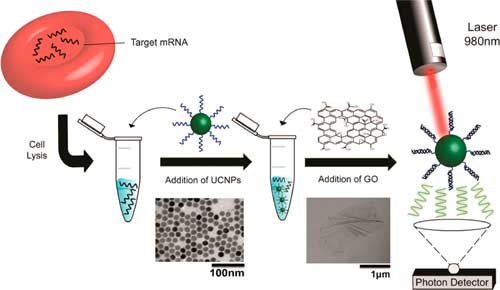
Schematic representation of the working principle of the biosensor. After lysis of the biopsy, the solution is mixed with nanoparticles coated with a sequence complementary to the target of interest. The graphene oxide is then added, and the sample is irradiated with a laser at 980 nm. Monitoring of the fluorescent signature of the particles allows the specific detection of the sequences.
Scientists at the University of Southampton have developed a new sensor, which can rapidly and accurately detect tiny amounts of oligonucleotides related to diseases (ACS Sensors, “Graphene Oxide-Upconversion Nanoparticle Based Optical Sensors for Targeted Detection of mRNA Biomarkers Present in Alzheimer’s Disease and Prostate Cancer”).
While the current work targeted Alzheimer disease and prostate cancer the sensor can be easily modulated to detect DNA biomarkers related to other diseases by specific sensing of mRNA and microRNA sequences present in cells.
The sensor works by initially attaching small oligonucleotide sequences (the sense strand) on the surface of fluorescent nanoparticles. In the presence of graphene oxide, the oligonucleotide coated nanoparticles are physically adsorbed onto the graphene oxide surface and their fluorescence is quenched.
However, in the presence of oligonucleotide targets complementary to the sense strand, the target hybridizes with the sense strand preventing the physical adsorption of nanoparticles to the graphene oxide surface, and retaining their fluorescence.
The group leader of the laboratory for Inorganic Nanoparticles and Applications (LICNA), Dr. Antonios Kanaras, says, “The beauty of this sensor is that with small modifications, it can be customized to detect any type of short oligonucleotide sequence specifically, in small amounts and rapidly, thus it offers possibilities for a broad use in disease diagnostics.”
Patrick Vilela, the scientist who carried out the experiments, says, “This technology will hopefully open the door for a quicker but still comprehensive detection of diseases. The dream is to treat disease detection as we do with normal blood analysis: with a simple vial and a week’s time, you can do a full range screening.”
Source: University of Southampton




